|
|
Nearly 17,000 plant and animal species are known to be threatened with extinction, while more than 800 have disappeared over the past 500 years, reports the International Union for Conservation of Nature (IUCN). The group warns that governments will miss their 2010 target for reducing biodiversity loss.
“When governments take action to reduce biodiversity loss there are some conservation successes, but we are still a long way from reversing the trend,” says Jean-Christophe Vié, Deputy Head of IUCN’s Species Program and senior editor of Wildlife in a Changing World, a report based on analysis of the 44,838 species on the IUCN Red List.
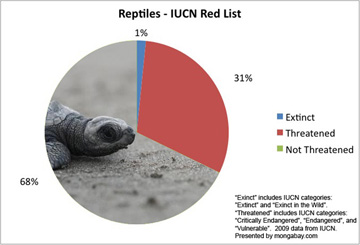 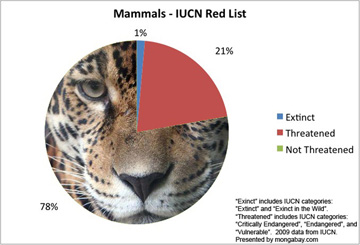 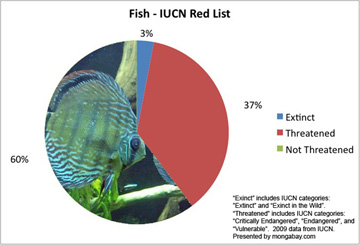 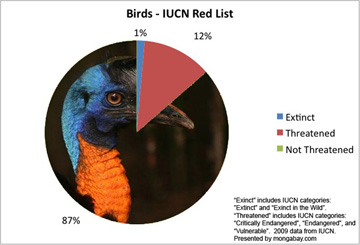 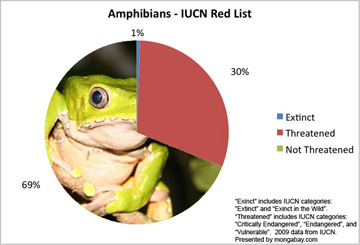 Click to enlarge |
“It’s time to recognize that nature is the largest company on Earth working for the benefit of 100 percent of humankind – and it’s doing it for free. Governments should put as much effort, if not more, into saving nature as they do into saving economic and financial sectors.”
The report shows that 869 species are “Extinct” or “Extinct the Wild” (rising to 1,159 if the 290 “Critically Endangered” species listed as “Possibly Extinct” are included) and at least 16,928 species are threatened with extinction. While these numbers are substantial, they are likely “gross” underestimates since only 2.7 percent of 1.8 million described species have been assessed. Scientists estimate there are 10-100 million species on Earth.
The report found some plant and animal groups to be particularly vulnerable. One third of amphibians, nearly a quarter of mammals, 27 percent of reef-building corals, 17 percent of sharks and rays, 29 percent of conifers, and 52 percent of cycads are threatened with extinction.
“The report makes for depressing reading,” says Craig Hilton Taylor, Manager of the IUCN Red List Unit and co-editor. “It tells us that the extinction crisis is as bad, or even worse, than we believed. But it also shows the trends these species are following and is therefore an essential part of decision-making processes. In the run-up to 2010, the global community should use this report wisely to address the situation.”
The report notes that the proportion of species at risk is expected to rise with as the planet warms. Land use change due to human development will interfere with migration to safer elevations and latitudes.
Wildlife in a Changing World (PDF)
Related articles
Extinction, like climate change, is complicated
![]()
(03/26/2007) Extinction is a hotly debated, but poorly understood topic in science. The same goes for climate change. When scientists try to forecast the impact of global change on future biodiversity levels, the results are contentious, to say the least. While some argue that species have managed to survive worse climate change in the past and that current threats to biodiversity are overstated, many biologists say the impacts of climate change and resulting shifts in rainfall, temperature, sea levels, ecosystem composition, and food availability will have significant effects on global species richness.
Biodiversity extinction crisis looms says renowned biologist

(03/12/2007) While there is considerable debate over the scale at which biodiversity extinction is occurring, there is little doubt we are presently in an age where species loss is well above the established biological norm. Extinction has certainly occurred in the past, and in fact, it is the fate of all species, but today the rate appears to be at least 100 times the background rate of one species per million per year and may be headed towards a magnitude thousands of times greater. Few people know more about extinction than Dr. Peter Raven, director of the Missouri Botanical Garden. He is the author of hundreds of scientific papers and books, and has an encyclopedic list of achievements and accolades from a lifetime of biological research. These make him one of the world’s preeminent biodiversity experts. He is also extremely worried about the present biodiversity crisis, one that has been termed the sixth great extinction.
Just how bad is the biodiversity extinction crisis?
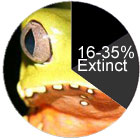
(02/06/2007) In recent years, scientists have warned of a looming biodiversity extinction crisis, one that will rival or exceed the five historic mass extinctions that occurred millions of years ago. Unlike these past extinctions, which were variously the result of catastrophic climate change, extraterrestrial collisions, atmospheric poisoning, and hyperactive volcanism, the current extinction event is one of our own making, fueled mainly by habitat destruction and, to a lesser extent, over-exploitation of certain species. While few scientists doubt species extinction is occurring, the degree to which it will occur in the future has long been subject of debate in conservation literature. Looking solely at species loss resulting from tropical deforestation, some researchers have forecast extinction rates as high as 75 percent. Now a new paper, published in Biotropica, argues that the most dire of these projections may be overstated. Using models that show lower rates of forest loss based on slowing population growth and other factors, Joseph Wright from the Smithsonian Tropical Research Institute in Panama and Helene Muller-Landau from the University of Minnesota say that species loss may be more moderate than the commonly cited figures. While some scientists have criticized their work as “overly optimistic,” prominent biologists say that their research has ignited an important discussion and raises fundamental questions about future conservation priorities and research efforts. This could ultimately result in more effective strategies for conserving biological diversity, they say.